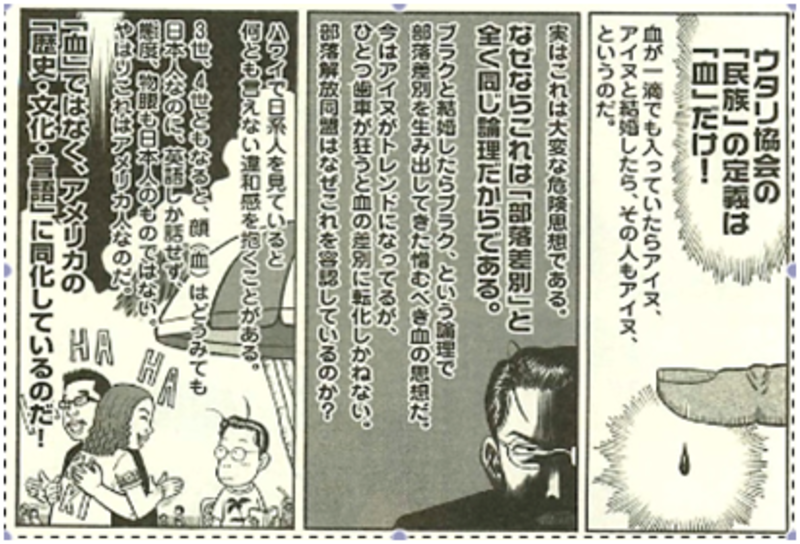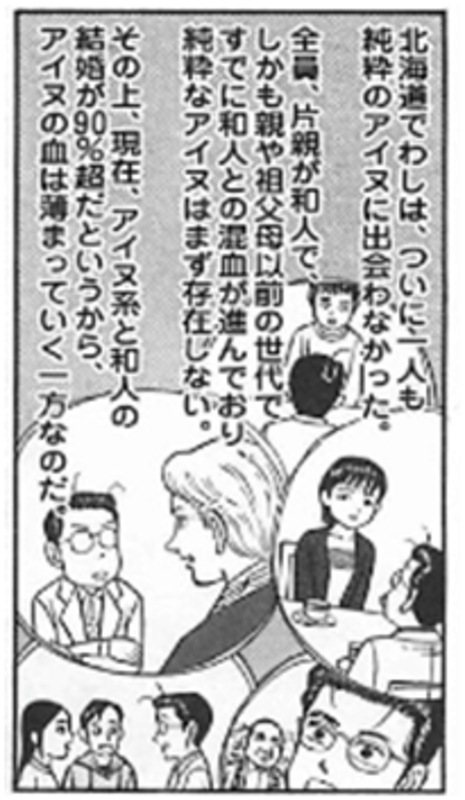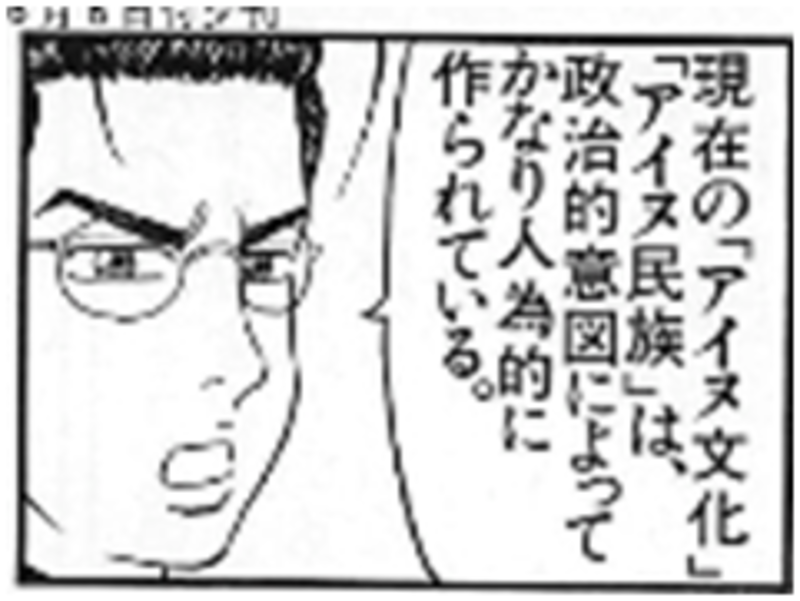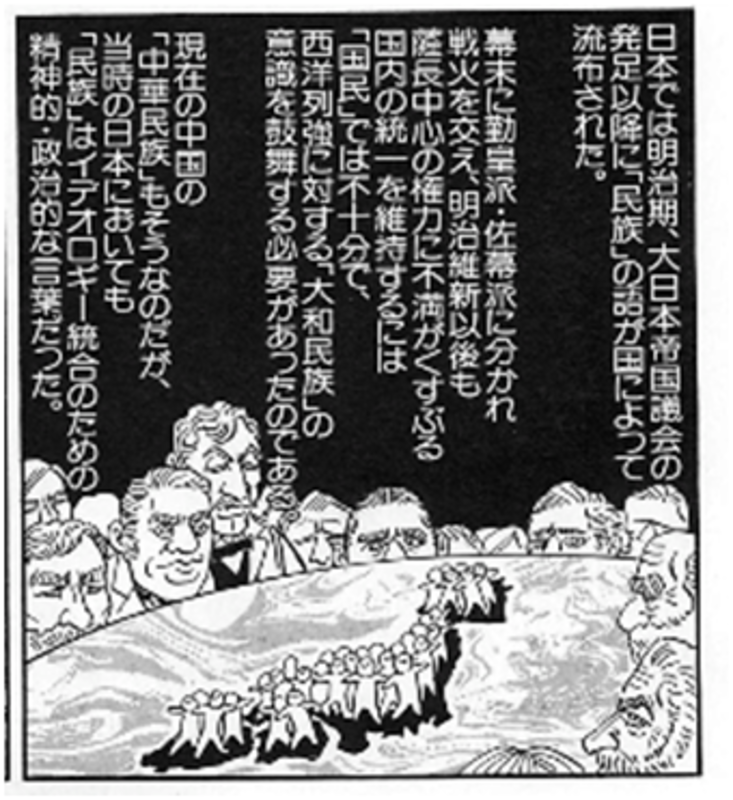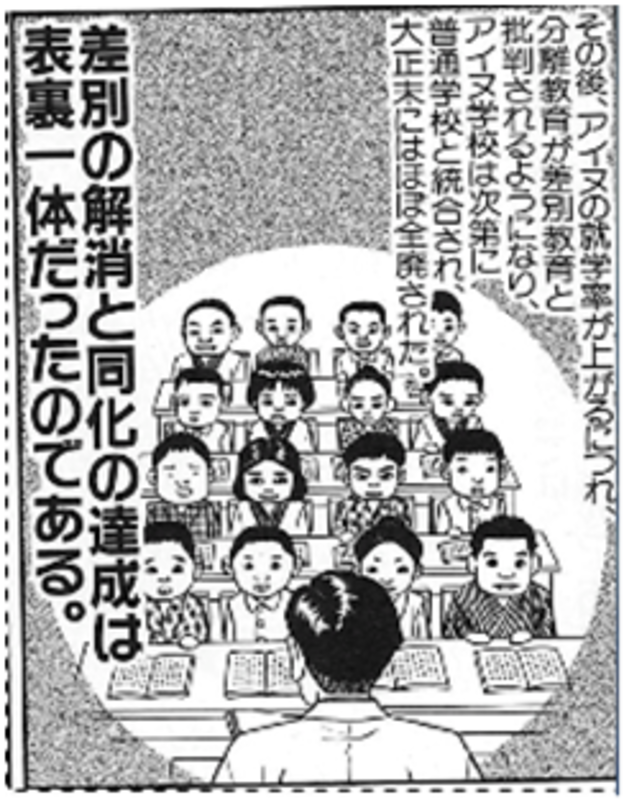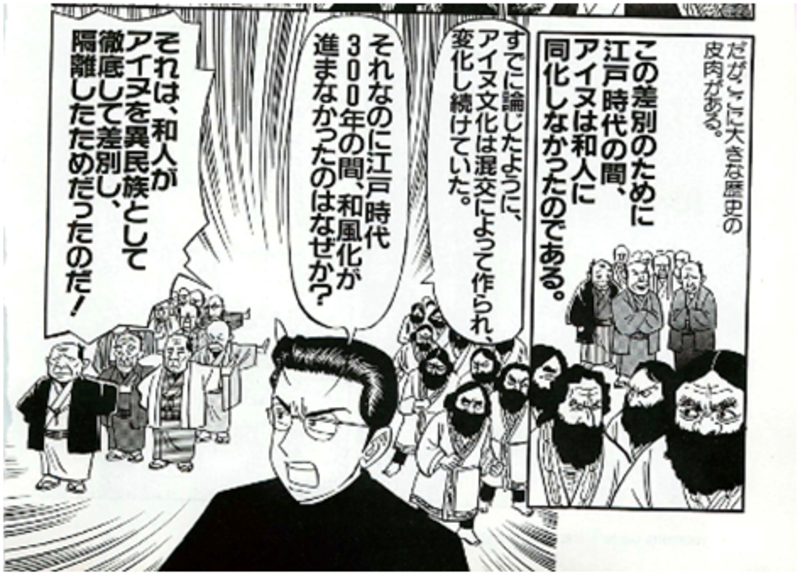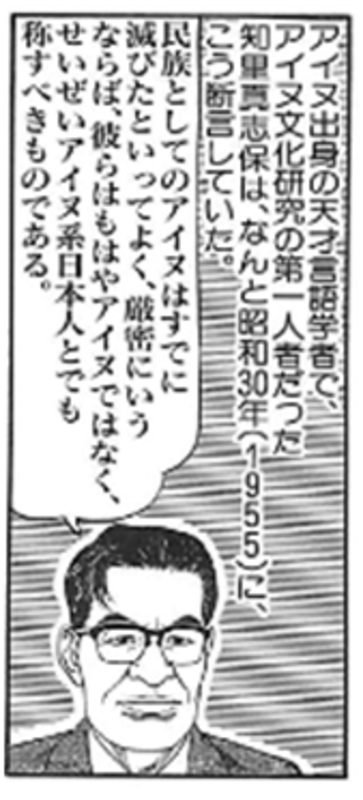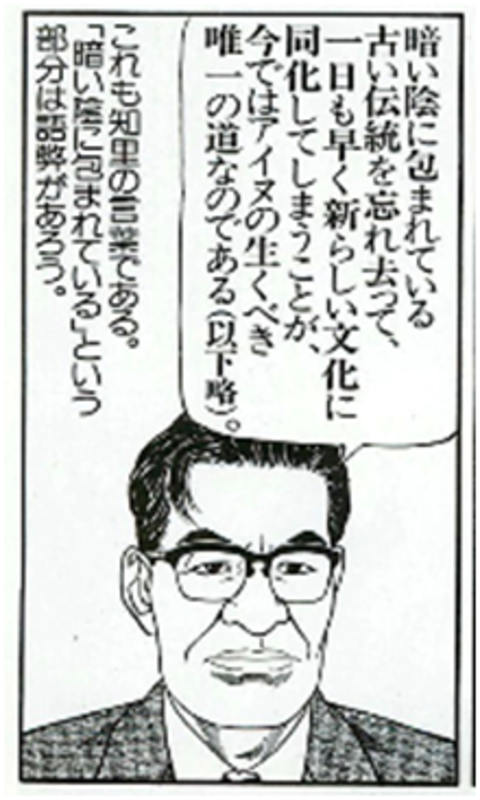Everything you know about Ainu is wrong: Kobayashi Yoshinori’s excursion into Ainu historiography
Mark Winchester
Geronimo’s Cadillac is waiting, and if we want, it can be a hell of a ride.
― Paul Chaat Smith1
Introduction
It is very difficult to say anything useful about Kobayashi Yoshinori today. Not least, because it was very hard to say anything about him in the first place. The lashings of masochistic self-irony in his work have been more than well commented upon. The more the manga artist and one contemporary face of cultural fascism2 in Japanese popular culture is criticized, the more it seems he feeds upon that controversy; the more he is pronounced “dead” as a significant cultural force, the more he seems to bounce back into necroperformative life.
Indeed, it is probably true that under contemporary conditions in Japan, the influence of Kobayashi’s entirely symptomatic desire from within this conjuncture to have people regard “life as just a means, not an end” and devote themselves to his nostalgic evocations of birthplace, family, and national community could be on the wane.3 To a large number of his fans, his excursion into Ainu history in early 2008 to 2009 (before finding a new muse in the form of the Heisei Emperor) must have seemed a fairly esoteric move to say the least.
Influence aside, however, as a historian of modern and contemporary Ainu thought, I found Kobayashi’s recent Ainu-ron (“theories on Ainu”) useful: a shame, but useful. Of course, in and of themselves, they are clearly little more than a direct reaction to the Diet Resolution Calling for the Recognition of the Ainu People as an Indigenous People (Ainu minzoku wo senjūminzoku to suru koto wo mitomeru kokkai ketsugi) passed on 6 June 2008. I found them useful, however, because, in places, he seemed to be aggravating the very contradictory and aporiatic tropes of Ainu history writing and, to an extent, contemporary Indigenous politics, that I feel have prevented people, from coming to terms with the “tumble of extraordinary contradictions”4 upon which colonial history thrives and works to recreate. This is why they are a shame: the task of coming to terms with that history has been left to someone like Kobayashi by the postwar Ainu history establishment. This has happened through its quite understandable interest in seeking histories of “resistance” (teikō) or “subjective Ainu history” (shutaiteki na Ainu-shi) to posit against earlier narratives of “assimilation” (dōka). However, just as Paul Chaat Smith has claimed that “silence about our own complicated histories supports the colonizer’s idea that the only real Indians are full-blooded, from a reservation, speak the language, and practice the religion of their ancestors,” a failure to engage with the complexity of issues such as “assimilation” and the meaning of modernity to Ainu history, has left that history wide open for people like Kobayashi to exploit. The “endless embrace of love and hate and narcissism” between Indians and other Americans Chaat Smith describes is only too familiar.5 The embrace between “Ainu” and “Shamo” (an Ainu word most commonly used in everyday speech to refer to non-Ainu Japanese) could not be any different. Yet now the aim of postwar Ainu historiography to create a “subjective Ainu history,” and the presumption that there is a single “Ainu” subjective line to take on it, has been exposed from the worst of possible corners.
It is with this in mind that I want to try and use Kobayashi’s work here as a way of approaching these problems in Ainu history – or indeed, the problem of “Ainu history” itself. In many ways, Kobayashi’s call is bizarrely similar to Chaat Smith’s – “everything you know about Ainu is wrong!” he screams at his audience – the only trouble is, as I hope to illustrate, he himself doesn’t actually realize why. In the words of critic, Takeuchi Yoshimi, therefore, I want to try and read Kobayashi in a way that aims to “extract the revolution from within the counter-revolution” so to speak.6 We might even go so far as to make the suggestion that Kobayashi Yoshinori’s work in this area demands a kind of “symptomatic reading” that separates its latent content from its manifest surface.
The reason I say this is because I think we can discover a hidden and quite different potential venture for thinking about Ainu history and politics under the surface of Kobayashi’s recent statements on “the Ainu”7, beginning with the Autumn 2008 special edition of the magazine Washi-sm entitled “Ainu as Japanese Nationals” (nihon kokumin toshite no Ainu). This is certainly a risky venture, but I want to attempt to read Kobayashi’s Ainu-ron – with all his logical contradictions, assumptions made for his own self-consistency, and just sheer oversight and misunderstandings (see the pictures accompanying this article) – as almost a kind of tool for exposing and breaking apart a specific part of Japan’s colonial, capitalist modernity that is being actively reconstituted in the present. In other words, what I want to call the desire of people to be and act as “Shamo” towards those designated to be “Ainu.”
It goes without saying that Kobayashi himself comes nowhere near to breaking down this phenomenon. In fact, he is a prime example of its contemporary repetition. However, at the same time, those engaged in whatever there is of an Ainu “public sphere” in Japan – to whom Kobayashi and his (“native” and otherwise) informants – Sunazawa Chinita, Sunazawa Jin, and cultural anthropologist Kōno Motomichi – have become a problem – have also been unable to confront the phenomenon. Those presently considering the future of Japan’s national Ainu policy come nowhere close.8 The reason for this, I argue, is that, throughout the postwar and into the present, they have been only too negligent of the twin problems of exclusionary inclusion of people to modernity in Japan under the onus of being “Ainu,” and the structural causality of discrimination to that historical break that has accompanied its maintenance ever since.
In spite of this negligence, however, it is my opinion that these two problems lie at the heart of modern and contemporary Ainu history. They are, so to speak, Ainu history’s proper, original, and yet hidden, theme. The point is a simple one: after modernity, certain people were constructed as desirable for inclusion to the nation as “Ainu” only to the extent that they were socially excluded on those very same terms.
Figure 1: One example of Kobayashi’s contradictions of logic. Here Kobayashi’s alter-ego wonders what the definition of the “Ainu People” (Ainu minzoku) is and quotes a version of the criteria for membership of the Ainu Association of Hokkaidō; criteria which had family connections (including adopted offspring) at center. He asserts that while the definition (?) of a minzoku (people/ethnos) is yet to be established, the Ainu Association fails to focus on the kind of “cultural elements” that seem to be widely agreed upon as minzoku criteria (Source: Kobayashi Yoshinori, “Gekiron-ban Gōmanism Sengen: Okinawa to Ainu, ‘Dōka’ wo dō kangaeru ka?,” Nishimura Kōsuke ed., Gekiron Mook: Okinawa to Ainu no Shinjitsu, Tokyo: ōkura Shuppan, 2009, p. 19).
Figure 2: Next, Kobayashi weighs in on the Ainu Association’s definition for having “blood” as its central tenet. He claims that this is similar to the burakumin situation in which even a single drop of burakumin blood ensures a risk of discrimination. For Kobayashi, this is a dangerous form of chi no shisō (“blood thinking”). He then compares this to Nikkeijin in Hawaii for whom, having “assimilated” to American history, culture and language, “blood” just doesn’t come into the picture (this is also his argument for calling Japan a “mono-ethnic state” (tan’itsu minzoku kokka) as, because Ainu culture developed as an hybrid amalgam in relation to Wajin (non-Ainu Japanese) culture, Ainu-Japanese (Ainu-kei nihonjin) are just one of the strands that make up the “mono-ethnic” Japanese people. He also uses this point to differentiate Ainu from Native Americans and Australian Aborigines who, unlike the Ainu, Kobayashi asserts, suffered genocidal oppression. (Source: Kobayashi Yoshinori, “Gekiron-ban Gōmanism Sengen: Okinawa to Ainu, ‘Dōka’ wo dō kangaeru ka?,” Nishimura Kōsuke ed., Gekiron Mook: Okinawa to Ainu no Shinjitsu, Tokyo: ōkura Shuppan, 2009, p. 20).
Figure 3: At the beginning of the same piece, however, Kobayashi’s alter-ego claims that he “didn’t meet a single pure Ainu in Hokkaidō.” He claims that, of all the people he met, at least one of their parents or grandparents was Wajin and that “mixed-blood” (konketsu) with Wajin has occurred for years. Thus “Ainu blood” continues to be “thinned-out” (usumatteiku). Whatever happened to chi no shisō? (Source: Kobayashi Yoshinori, “Gekiron-ban Gōmanism Sengen: Okinawa to Ainu, ‘Dōka’ wo dō kangaeru ka?,” Nishimura Kōsuke ed., Gekiron Mook: Okinawa to Ainu no Shinjitsu, Tokyo: ōkura Shuppan, 2009, p. 11).
The Pity about Being “Shamo”
I want to start with some speculative reflection on the Kobayashi Yoshinori phenomenon because I think that, in many ways, the notion of being “Shamo” that I want to get at, is often exposed at its most typical in his manga. It goes without saying that Kobayashi himself is an almost iconic figure of the culture of the 1990s Japanese recession. For what it is worth, Kobayashi has stated numerous times that his motivation for creating his Gōmanism Sengen (“Haughtiness Manifesto”) series began with his dismay at the attitudes of his fellow advocates for patients during the 1980s HIV-tainted blood scandal, and then the actions of the young Aum Shinrikyō perpetrators of the 1995 Sarin gas attack on the Tokyo subway. His conclusion as to the origin of his disappointment in these figures of misguided youth involved the typically cultural fascist trope of positing the atomized notion of the consumerist “individual” as something that has “been formed as irrelevant to kō (the public or community).” He has claimed he felt “eerie that an increasing number of young people are throwing over board their common sense,” and that, through drawing his infamous WWII manga, Sensōron (On War) from the same year, he was attempting to create “a story on the interwar period, when individuals and community, individuals and the nation-state were strongly connected.”9
That he chose to appeal to this sense of national community through the mass-consumer, aesthetic form of manga surely only adds a further ironic twist to the assertion that, in fascist cultural production, the “ideological-political domain” must “be stylized through the techniques and technologies of mass cultural production,” and “in turn subordinated to the aesthetic demands of the ‘mass ornament:’”10 the colorful doorstep of a Kobayashi Yoshinori manga squatting neatly on a private home bookshelf.
To make an initial speculative point, then, I would imagine that, even if not fully aware of it themselves, a large number of Kobayashi’s fans consist of people who have faced all manner of new social processes of peripheralization during these same decades. Indeed, even with the slightest understanding of the processes of contemporary State de-and-re-nationalization this fact should be self-evident to the extent that any of Kobayashi’s readers are “nationals” (kokumin) at all. Kobayashi is not wrong to, at least intuit, the reality that a steady process of state denationalization has occurred in response to the 1990s recession and to fit more recent tendencies of capital accumulation outside traditional industrial and agricultural sectors.
Just like Kobayashi’s alter-ego in the Gōmanism Sengen series, then, we can imagine that his fans are generally people who have come to embrace a sense of crisis in that the connection between themselves and the country to which they supposedly belong could, at any moment, become irrevocably vulnerable and untenable. In this sense, those who instinctively empathize with Gōmanism Sengen (whether in spite of, or because of, its irony) have something almost pitiable (to give a Japanese term: kawaisō) about them.
They must be constantly caught up in a psychology that demands they see themselves as repeatedly under siege. Moreover, the country they see before their eyes must appear as if it is always derailing itself from its original, intended path. For this reason they cannot but learn and acquire a kind of twisted and unrequited love for a “Japan” that no longer wishes to care and support them.11
These readers, along with Kobayashi’s alter-ego, try their upmost to defend a country that has withdrawn itself from a wide range of responsibilities concerning the survival of its nationals according to previous forms of popular discipline. They try to defend a country, which can no longer enact its sovereignty in the same manner as before, through attempting to ensure that broken public commitments are re-promised. Overflowing with a spirit of revenge, they embrace this kind of empty hope and idealism – making the now familiar cry that Japanese “society must be defended.” Even if they do not embrace such high-minded idealism, unless they believe the major premise that “Japan” is somehow a “good country,” they somehow cannot imagine it even possible to proceed forward. They cannot rest unless they rebuild this sacred canopy “Japan” and defend it from everything and everyone that would have it fall apart. They do indeed wish to postpone living in the present so that they can give themselves up to the future of the country, even if this is ultimately an un-demanded and now nigh impossible task. In short, they are the typical modern vagabonds who embrace the kind of hope that Nietzsche abhorred as the basis for their deepest desires; the kind of “hope [that] is the worst of all evils, because it prolongs man’s torments.”12
Figure 4: In his first outing into Ainu historiographic territory, Kobayashi’s inked-self claims, “Today’s ‘Ainu culture’ and the ‘Ainu People’ are, to a great extent, fabricated according to political motives” (Source: Kobayashi Yoshinori, “Gōmanism Sengen extra: Nihon Kokumin toshite no Ainu,” in Kobayashi Yoshinori ed., Washi-sm: Nihon Kokumin toshite no Ainu, Tokyo: Shōgakkan, 2008, p. 44).
Figure 5: And yet, in explaining the existence of the “Yamato people” (Yamato minzoku), he claims, just like with the notion of “the Chinese” (chūka minzoku) today, the “Yamato people” was an important “psychological and political word used for ideological cohesion” against the threat of Western powers and to counter internal strife after the Meiji Restoration. Empiricism and political pros and cons aside, is it so hard to imagine that the “Ainu people” (Ainu minzoku) enjoys a similar ideological purpose with regard to, say Indigenous rights? (Source: Kobayashi Yoshinori, “Gōmanism Sengen extra: Nihon Kokumin toshite no Ainu,” in Kobayashi Yoshinori ed., Washi-sm: Nihon Kokumin toshite no Ainu, Tokyo: Shōgakkan, 2008, p. 19).
The now familiar insight of Lacanian psychoanalysis that “lack (“castration”) is originary” also precisely describes this state of being.13 Kobayashi and his alter-ego’s vision for “Japan” can only be embraced as something viable through the nagging presentiment that the “Japan” they wish to defend simply doesn’t exist in the first place. In order for that “Japan” to be viable they must discover as many phantom-like “fifth columnists” as possible. Their vision can only ever be a “stolen” one. In order to prove that “Japan” is a “good country” too, any number of cumbersome obstacles preventing people from realizing the fundamental truth of this presumption must be uncovered and displayed for all to see. This is why the figure of the “righteous lad” (seigi-kun) “lefties” (sayoku, in Katakana) who try desperately to “purify themselves through masochistically attacking their own country” must appear again and again and again, as too must those concession-hunting profiteers who hound after good taxpayers’ money while they wrap the country in chains, preventing it from operating as it should.
Alongside this, however, I want to suggest that Kobayashi’s strange sense of good will and conscience toward the figures of “the Ainu” and “Okinawans,” who, we are told, have been sorely prevented from attaining the same status as other Japanese nationals, actually operates in the same way. Unless “the Ainu,” for instance, are not somehow kept in the contradictory status of what, after the 1970s Ainu poet and intellectual Sasaki Masao, I want to call being “nationals who are unequal to [other] nationals” (kokumin nami de wa nai kokumin)14, then Kobayashi presents himself with a problem. Kobayashi has stated clearly and consistently that he is completely against the “fabrication of [the Ainu as] an ethnic group” (minzoku no decchi-age) that will result in the “dissolution of the state” (kokka kaitai) and that he desires to find a way of “speaking that will not encourage those who live as Japanese and hide their Ainu heritage to feel guilty.”
Interestingly, this assertion would also seem to be somewhat in conflict with positions Kobayashi has taken on discrimination, particularly in regard to Burakumin in the past. For Burakumin, the notion that, in response to discrimination, they might appeal to ideas of humanity, rather than assert a specific cultural identity – as epitomized in the Suiheisha Declaration of 1922 – was, for Kobayashi, abhorrent. Blacks, in response to discrimination against their children, did not come back with statements to the effect that, “I did not give birth to a black child, I gave birth to a human child!” Japanese did not come back with, “I did not give birth to a Japanese child, I gave birth to a human child!” so why should Burakumin feel they must assert, “I did not give birth to a Buraku child, I gave birth to a human child!”?15 In contrast, Kobayashi’s solution is to stage a spectacular “The Buraku Ultra-Liberation Festival” (za Buraku urutora kaihō fesu) to assert a new cultural identity.16 No doubt he would argue that this new Buraku identity would constitute just a part of his multi-identity, yet mono-ethnic vision of the nation. While the question of how this Buraku identity might differ from the “psychological and political word used for ideological cohesion” he claims the “Yamato People” is unclear; what is clear is that there is obviously a line people cannot cross in his scheme – and that it is Kobayashi himself, in his role as a nationally empowered “spatial manager”17 of his nation who decides where that line must be set.
This aside, however, Kobayashi has stated that he wants to thoroughly fight discrimination so as to allow “Ainu” to enjoy equal lives as Japanese nationals.18 What he refuses to see though is the blind truth that unless “Ainu” are discriminated against, there is no way, shape, or form through which he can attempt to save them. Kobayashi requires the discrimination that forces “Ainu” to be “nationals who are unequal to nationals.”
Nationals who are unequal to nationals
The central tenant of Kobayashi’s stance regarding “the Ainu” is more or less condensed in the following phrase from his manga: “the solution to discrimination and the achievement of assimilation were two sides of the same coin.”19 From the point of view of Ainu policy, there is actually very little wrong historically about this statement. Achieving assimilation was indeed seen by Japanese policymakers as the best way to solve the problem of continued discrimination toward “the Ainu.” The problem for Kobayashi, is that he either cannot, or refuses, to see just why this was the case.
Figure 6: The assertion that “the solution to discrimination and the achievement of assimilation were two sides of the same coin” occurs in the context of post-Meiji Ainu education. The elimination of discrimination meant the elimination of separate Ainu schools set up under the 1899 Protection Act. Dōka, or “assimilation,” thus becomes an elegant circle – a response to previous attempts to achieve its aims (Source: Kobayashi Yoshinori, “Gōmanism Sengen extra: Nihon Kokumin toshite no Ainu,” in Kobayashi Yoshinori ed., Washi-sm: Nihon Kokumin toshite no Ainu, Tokyo: Shōgakkan, 2008, p. 31).
Figure 7: “Ainu culture” developed in a hybrid fashion alongside “Wajin culture.” So, why was it that after 300 years of the Edo period “Ainu” had not “Japanified”? Answer: “because Wajin thoroughly discriminated against Ainu as a different ethnicity and isolated them” from the rest of society. Not exactly wrong (Source: Kobayashi Yoshinori, “Gōmanism Sengen extra: Nihon Kokumin toshite no Ainu,” in Kobayashi Yoshinori ed., Washi-sm: Nihon Kokumin toshite no Ainu, Tokyo: Shōgakkan, 2008, p. 28).
What is surprising, however, is despite this refusal, the reason is brilliantly illustrated in Kobayashi’s manga itself. The reason why pre-modern “Japanification” (wafūka) and modern “assimilation” (dōka) were not ultimately successful and achieved was precisely, as Kobayashi himself asserts, “because Wajin thoroughly discriminated against Ainu as a different ethnicity and isolated them [from national society]!”20 It is this point which supplies the main cause for Kobayashi performing the role of “Shamo” so well in his attitude displayed toward “Ainu” in his manga: he refuses to pursue the relationship that exists between discrimination and assimilation.
Lurking within his statement to the effect that “the solution to discrimination and the achievement of assimilation were two sides of the same coin,” however, is the specific nuance that without the aim of “solving discrimination,” the ideal of “achieving assimilation” becomes an impossible one to uphold. In other words, it is none other than discrimination and exclusion that provide the necessary conditions for “the Ainu” to be saved. Or, to put it yet another way, the one thing that the “assimilation” (dōka), “nationalization” (kokuminka), “modernization” (kindaika), and “civilizing” (bunmeika) of “the Ainu” could absolutely not do without, was the motivational force, or structural causality, of discrimination that bound them into forever being “nationals who are unequal to [other] nationals.” In order for the “assimilation,” “nationalization,” “modernization,” and “civilization” of “the Ainu” to take place – and in order for that path to modernity to be perceived as an entirely natural development – they had to be first interpellated into modern Japanese society as “nationals unequal to nationals” – or, in other words as “Ainu” after the fact of modernity.
This process was also reciprocally related to the material conditions of life that “Ainu” found themselves having to live in. The aforementioned 1899 Hokkaidō Former Natives Protection Act is a case in point. The law was designed to solve the problem of just what land belonged to “Ainu” and what land could be freed up for further development. It was designed to give only those who desired to live a lifestyle based upon agriculture the bare minimum necessary social welfare allowances to do so. In order for the law to have been conceived of in the first place, therefore, “the Ainu” had to have been perceived of as either unproductive or progressively lagging “nationals unequal to nationals” – a perception materially provided for by the recent history of their colonial displacement. Furthermore, however, due to the laissez faire enactment and management of the provisions provided by the law, and the fact that restrictions were placed upon the transfer of allotments granted by the act, the fact that allotments could not be sold or used to obtain a mortgage, as well as the fact that much of the land granted was unsuitable for agricultural production, uncultivated or prone to flooding, “the Ainu” were once again put in a position of “nationals unequal to nationals” and thrown back into colonial society, often forced into becoming seasonal migrant laborers to make ends meet.
Just as Frantz Fanon asserted for colonies elsewhere, therefore, for “the Ainu” too, after modernity “the cause is [always already] effect.”21 Or, as Ainu historian, Ogawa Masato has it, “because the revisions to the Protection Act were not something that answered Ainu demands, further action and demands calling for the eradication of discrimination on behalf of the Ainu had to be maintained.”22 The raw truth of this sentence lies in its extreme literal interpretation. It is precisely because Ainu policy throughout the modern and contemporary periods failed miserably that “the Ainu” were preserved as a form of life in which they were always already “nationals unequal to nationals,” and from within that form of life they could do nothing else but attempt to confront and create a new identity for themselves.
In other words, we can agree with historian Hirota Masaki that it is “modernity itself that gives rise to discrimination,” and “equality itself that is a cunning and suspicious figure” (kusemono).23 The colonial, capitalist modernity of Japan that began its process of imperialization with events such as the colonization of Hokkaidō has ever since only been able to ensure the success of its aims and continuity through such useful and contingent existent social mechanisms as discrimination. Kobayashi Yoshinori, in his desire to embrace once again “the Ainu as Japanese nationals” into the warm bosom of the nation clearly succeeds in repeating this task by reproducing a completely incommensurable figure of the “Ainu” Other as an outside form from inside this logic. It is not just those who would wish “the Ainu” to be excluded from society, but even those who would embrace them with conditions that cannot help but place “the Ainu” in a position of subservience in that very empowered and empowering act of embrace.
In this sense, Kobayashi Yoshinori, in his attempt to incorporate “the Ainu” into his dreams of national palingenesis, is not only a thoroughly modern liberal, but also a multiculturalist in exactly the same form as those previously active in the Greater Japanese Empire.24 This is because, if “Ainu” are not seen as somehow “nationals unequal to nationals,” then the status of “Shamo” as somehow “originally equal nationals” becomes impossible to even fathom and his dreams will be lost. This is the psychology, the pitiable fate that has been inscribed upon those who feel they must act like “Shamo” toward “Ainu” under modernity. “Ainu” must, from the very notion that they are “Ainu” in the first place, always be the objects of salvation.
Chiri Mashiho’s Truth
While feigning scandal and taboo in page after page of the outbursts of his inked other self, if there is actually anything that is genuinely scandalous about Kobayashi’s Ainu manga, it is his appropriation of the words of Ainu linguist and intellectual, Chiri Mashiho (1909-1961) for his project. This appropriation certainly fits a pattern of a deliberate technique of ventriloquizing key figures and their intellectual positions in his manga from subject to subject, clearly attempting to add a sense of authenticity through including a member of the respective “parties concerned” (tōjisha). For instance, Communist and outspoken critic of the American presence in Okinawa, Senaga Kamejirō in his 2005 Okinawaron (On Okinawa), or the Buraku Liberation League’s Kumisaka Shigeyuki in his 1998 Sabetsuron (On Discrimination).
Kobayashi uses two quotes from Chiri’s work, one from a short article Chiri wrote in 1955 for Japanese publishing house, Heibonsha’s Sekai Daihyakkajiten (World Encyclopedia) simply called “Ainu”, and the other from Chiri’s own Ainu Mintanshū (Ainu Folk Stories), published in 1937.
As a people/ethnos (minzoku) it can be said that the Ainu have already died out, and if we were to be precise about the matter, they are no longer Ainu, but, at best, we should refer to them as Ainu-Japanese (Ainu-kei Nihonjin).25
We can say that in all sectors of life the ‘lifestyle of the Kotan (Ainu settlement)’ has completely died out. There are hardly any people who can disseminate and pass on the old language or tales and stories. Among men over fifty years old this is particularly the case, let alone both men and women under forty. Even those few elder women who have survived, today they are completely Japanified (nihon-ka) and among them there are women in their seventies who use abacus to calculate, keep account books, and others who have modernized to the extent that they are called by modern nicknames. There is even one woman who can read and write English. There are also women who read the newspaper every day without fail and debate about the vote for women. Surely this is a degree of assimilation that naichijin [those living in Japan proper as opposed to the “colonies”] couldn’t even begin to imagine.26
Figure 8: Chiri, the “genius linguist of Ainu origin” and the scholar at “the forefront of Ainu culture studies” claimed in 1955 that Ainu “as a people/ethnos (minzoku) can be…” (Source: Kobayashi Yoshinori, “Honke Gōmanism Sengen Dai-rokuwa: Ainu ‘Minzoku no Decchi-age’ wo Yurusuna!” [Original Haughtiness Manifesto Part Six: Do not Forgive the ‘Fabrication of an Ethnic’ Ainu!], in WiLL, Tokyo: Wakku Shuppan, April 2010, p. 198).
Figure 9: Chiri, in the afterword to Ainu Mintanshū, written in 1935, states, “the only path that the Ainu should try to live upon today is that in which they forget the old traditions wrapped in dark shadows and assimilate to a new culture as soon as possible.” The questions ignored here, however, are what Chiri meant by “assimilate” and “new culture.” That the break of modernity, and the problem of its critique and affirmation, provided the core motivation behind Chiri’s academic work is clear (Source: Kobayashi Yoshinori, “Gōmanism Sengen extra: Nihon Kokumin toshite no Ainu,” in Kobayashi Yoshinori ed., Washi-sm: Nihon Kokumin toshite no Ainu, Tokyo: Shōgakkan, 2008, p. 17).
What is scandalous about Kobayashi’s appropriation of these quotes is that Chiri’s phrase “Ainu-Japanese” (Ainu-kei nihonjin), which Kobayashi is so keen to highlight as an example of Ainu assimilation, represented, at heart, the despair of one who realized that it is “precisely the modern which always conjures up prehistory.”27 For Chiri, expressing the current condition of being “Ainu” as being irreversibly “Ainu-Japanese,” there was no real question of “assimilation” or “dissimilation” involved at all. It was merely the expression of someone for whom the only ever retroactively visible consistency of his culture had been strained to breaking point, and so he was determined to look his situation straight in the face and stick through it to the very end.
Of course, Kobayashi pays very little attention to the different historical contexts in which the quotes he takes from Chiri were made. They merely appear as the authoritarian words of an “Ainu,” under the patronizing rhetoric which has been used for so long by so many to avoid actually engaging with Chiri’s work critically – the “genius Ainu linguist” (Ainu no tensai gengogakusha). There is no sense, for instance, of the, at least, three different stages of Chiri’s life. There is no sign of the young student who felt he represented little more than “the goods” (shinamono) to his teacher, Kindaichi Kyōsuke. There is no sense of the wartime researcher at the Karafuto Museum who asserted that if Japan was to take a leading role among the various peoples in greater East Asia, then Ainu research could play a leading role in that quest to gain a better understanding of the “ethnic psyche,” and who stated quite clearly that Ainu, “whether in terms of responsibility as soldiers or paying taxes, are every bit the same as other national subjects, and that even in the Great Asian War, there are more than a few who have become heroes enshrined at Yasukuni.”28 And, there is no sign of the postwar Hokkaidō University professor of linguistics who contributed greatly to recording Ainu place names and compiling an Ainu language dictionary. None of these Chiris appear in Kobayashi’s version.
Of course, it goes without saying that the wartime Chiri, like other colonial subjects, no doubt found himself in a precarious situation in which he was always at risk of ostracism, either as a fully fledged member of the nation, or in Chiri’s case, that nation’s academy. However, he did not, as Kobayashi tries to assert, simply hope that “Ainu” would choose to “decisively quit calling themselves Ainu and live as Japanese.”29
To put it bluntly, Chiri can be said to have attempted, with great effort, to infuse his term “Ainu-Japanese” with a sense that, again in the words of Takeuchi Yoshimi, the subject is only “a true slave when he thinks that he is not a slave.”30 To be “Ainu-Japanese,” for Chiri, meant to face straight on the full force of colonial history and realize that he could be no other – that he “becomes a slave who realizes he is a slave”31 to the break of the modern. He cannot but be absolutely modern, precisely because of his liminal state constantly required to assimilate and display proof of that assimilation. For Chiri, there was no going back.
To quote critic Kamada Tetsuya, the truth of Chiri’s assertion perhaps lays in what Kamada calls his “struggle” (tōsō), which spanned his life in pre, wartime, and postwar Japan.32 This was “a struggle, not so much based upon the opposition between those who are well-grounded and have authority (konkyo wo motsu mono), and those who do not, but rather between those who reject the desire to act as if one is well-grounded when one is not, and those who would force a fabricated grounded-ness upon an Other.”33 To translate this point into my argument: to “act as if one is well-grounded when one is not” is, of course, exactly the psychology of those “Shamo” who would try to defend that which does not exist (“Japan”), and those “Ainu” who, being not at all free from the awareness that would decide their fate in relation to “Shamo,” try to somehow return to an authentic image of “the Ainu” only made possible by the break of the modern itself. Similarly, “those who would force [such] a fabricated grounded-ness upon an Other” is a perfect description of how to act “Shamo” and of how some “Ainu” act toward other “Ainu” in demanding the same level of “Ainu-ness” from them as that which they display themselves. Chiri is the one who “rejects” this choice.

Figure 10: Chiri Mashiho (1909-1961). Photo taken in January 1960 (Source: Fujimoto Hideo, Chiri Mashiho no Shōgai: Ainu-gaku Fukken no Tatakai, Tokyo: Sōfūkan, 1994, p. 15). |
At the end of the day, then, there is nothing really new about Kobayashi Yoshinori’s sojourn into Ainu history. Whether it be the arguments of someone like the “father of Ainu/Hokkaidō history” Takakura Shinichirō, who tried to retroactively legitimize the Hokkaidō Former Natives Protection Act as a humanist measure; the equality demanded by those who sought the abolition of that same Act in accordance with the ideals of postwar democracy in the postwar years; the human rights sought by those who saw the “Ainu problem” as an unfinished challenge for the same postwar democracy in needing to account for the rights of minorities and indigenous peoples; or even the multi-ethnic co-existence that would have every Japanese national today “respect the pride of the Ainu people,” an ideal epitomized in the 1997 Ainu Cultural Promotion Act – all of these efforts running throughout modern and contemporary Ainu history – just like Kobayashi Yoshinori, have taken place with the image of “the Ainu” as “nationals unequal to [other] nationals” as their premise.
They all ultimately have had the persistence of the need to be “Shamo” toward “Ainu” at base. This is why, in a way, I too want to make an appeal to those who would try to save and uplift “the Ainu,” and those involved in Ainu policy making today. Chiri Mashiho’s efforts may have finally ended in failure, and Kobayashi’s appropriation of them might be proof of this. However, do you not think it is high time that, as Chiri once tried, we all finally and honestly look our present realities in the face, show them some fidelity and relearn the kind of “solitude” needed to bear with that reality instead of continually looking toward communal dreams that would have us escape it? That we work against discrimination to reveal the world as it actually is; a world in which being “Ainu,” or “Shamo,” or anything else for that matter, is of no more significance than being a person full stop?
Mark Winchester is currently a JSPS postdoctoral fellow at the Graduate School of Social Sciences, Hitotsubashi University. He has published articles on contemporary Ainu issues in the Japanese journals Gendai Shisō and Impaction, as well as in English at The Asia-Pacific Journal.
Recommended citation: Mark Winchester, Everything you know about Ainu is wrong: Kobayashi Yoshinori’s excursion into Ainu historiography, The Asia-Pacific Journal Vol 9, Issue 22 No 1, May 30, 2011.
Articles on related subjects
• Simon Cotterill, Ainu Success: the Political and Cultural Achievements of Japan’s Indigenous Minority
• Mark Winchester, On the Dawn of a New National Ainu Policy: The “‘Ainu’ as a Situation” Today.
• Yukie Chiri and Kyoko Selden, The Song the Owl God Himself Sang.”Silver Droplets Fall Fall All Around,” an Ainu Tale
• Katsuya HIRANO, The Politics of Colonial Translation: On the Narrative of the Ainu as a “Vanishing Ethnicity”
• ann-elise lewallen, Indigenous at last! Ainu Grassroots Organizing and the Indigenous Peoples Summit in Ainu Mosir
• Sonia Ryang, The Denationalized Have No Class: The Banishment of Japan’s Korean Minority– A POLEMIC
• Chisato “Kitty” O. Dubreuil, The Ainu and Their Culture: A Critical Twenty-First Century Assessment
• David McNeill, Oda Makoto, Pak Kyongnam, Tanaka Hiroshi, William Wetherall & Honda Katsuichi, The Diene Report on Discrimination and Racism in Japan
• Joshua Hotaka Roth, Political and Cultural Perspectives on Japan’s Insider Minorities
Notes
An earlier version of this paper appeared in Japanese as: Mark Winchester, “‘Shamo’ he no Koshitsu: Kobayashi Yoshinori to Gendai Haigai (Hōsetsu)-shugi” [The Persistence of Being ‘Shamo’: Kobayashi Yoshinori and Contemporary Exclusion/Inclusionism], in Impaction, No. 174, Tokyo: Impact Publishers, May 2010, pp. 103-111. I would like to thank Ukai Satoshi for giving me the opportunity to write it and Mark Selden for the opportunity to translate it. I would also like to thank Gavin Walker and the folks at Zap’em in Kunitachi for the chance to talk about it.
1 Paul Chaat Smith, Everything You Know about Indians Is Wrong, Minneapolis & London: University of Minnesota Press, 2009, p. 27.
2 Here, “cultural fascism” is not at all meant as a pejorative epithet. The ideological edifice of fascist fantasy is, according to Slavoj Žižek, “to have capitalism without its ‘excess,’ without the antagonism that causes its structural imbalance;” to strive toward, “a harmonious corporate body, where, in contrast to capitalism’s constant social displacement, everybody would again occupy his own place” (Slavoj Žižek, Tarrying with the Negative: Kant, Hegel, and the Critique of Ideology, Durham: Duke University Press, 1993, p. 210). To imagine that certain minzoku (ethnos/nation), and sabetsu (discrimination) in and of itself, are the reason for society’s structural imbalance and a barrier to achieving an organic community that transcends these divisions, rather than ideological phenomena involved in a nexus of historically contingent and immanent forces which have proved entirely useful to Capital when it confronts the instability of the supply of labor power that it can attempt to commodify (i.e. leading to the racialized fractionalization of class in the production of the so-called “relative surplus population”), seems to me to be precisely a problem of seeking capitalist society without its “excess.” The notion of “generic fascism,” as well as the reluctance to appeal to the term fascism in regard to Japan due the problem of Western exceptionalism might also be useful in thinking about this point in terms of Kobayashi’s work, but these issues are far beyond the scope of this paper. Interestingly, Kobayashi has made the claim that discrimination is “incorporated into capitalism as a necessary system;” that even if discrimination toward, for instance, Burakumin were to abide, capitalist society would find some other basis for discriminating against specific populations (Kobayashi Yoshinori, Gōmanism Sengen: Sabetsuron Supesharu [Haughtiness Manifesto: Special on Discrimination], Tokyo: Gentōsha Bunko, 1998, p. 88). He refuses the solution of a “Thomas Moore”-like “socialist revolution” in favor of lessening the effects of current discrimination (p. 95).
3 Mark Driscoll, “Kobayashi Yoshinori is Dead: Imperial War/Sick Liberal Peace/Neoliberal Class War,” Mechademia, Vol. 4, Minneapolis: University of Minnesota Press, 2009, pp. 290-303.
4 Chaat Smith, Everything You Know about Indians Is Wrong, p. 27.
5 Chaat Smith, Everything You Know about Indians Is Wrong, p. 6.
6 Takeuchi Yoshimi “Nashonarizumu to Shakai Kakumei” [Nationalism and Social Revolution], in Marukawa Tetsushi & Suzuki Masahisa eds., Takeuchi Yoshimi Serekushon I: Nihon no/kara no Manazashi [Takeuchi Yoshimi Selection Volume I: The Gaze of/from Japan], Tokyo: Nihonkeizaihyōronsha, 2006, pp. 166-174, p.173.
7 To offer a fairly comprehensive list of Kobayashi’s Ainu-related work since 2008: Kobayashi Yoshinori, “Gōmanism Sengen extra: Nihon Kokumin toshite no Ainu” [Haughtiness Manifesto extra: Ainu as Japanese Nationals], in Kobayashi Yoshinori ed., Washi-sm: Nihon Kokumin toshite no Ainu, Tokyo: Shōgakkan, 2008, pp. 11-50; Kobayashi Yoshinori, “Gōmanism Sengen Dai-sanjūgoshō: Ainu wa Senjūminzoku na no ka?” [Haughtiness Manifesto Part Thirty Five: Are the Ainu an Indigenous People?], in Sapio, Tokyo: Shōgakkan, 12 November 2008, pp. 59-66; Kobayashi Yoshinori, “Gōmanism Sengen Dai- sanjūnanashō: Genron Fūsatsuma no Bōryaku” [Haughtiness Manifesto Part Thirty Seven: The Plot of a Devil of Suppressing Speech], in Sapio, Tokyo: Shōgakkan, 17 December 2008, pp. 59-66; Kobayashi Yoshinori, “Gekiron-ban Gōmanism Sengen: Okinawa to Ainu, ‘Dōka’ wo dō kangaeru ka?” [Haughtiness Manifesto Extreme Debate Version: Okinawa and Ainu, How should we think about “Assimilation”?], Nishimura Kōsuke ed., Gekiron Mook: Okinawa to Ainu no Shinjitsu [Extreme Debate Mook: The Truth of Okinawa and the Ainu], Tokyo: ōkura Shuppan, 2009, pp. 9-26; Kobayashi Yoshinori, “Gōmanism Sengen: Jishō Ainu wa Jitsu wa Nihonjin de aru” [Haughtiness Manifesto: Self-proclaimed Ainu are Actually Japanese], in Sapio, 9 September 2009; Kobayashi Yoshinori, “Honke Gōmanism Sengen Dai-rokuwa: Ainu ‘Minzoku no Decchi-age’ wo Yurusuna!” [Original Haughtiness Manifesto Part Six: Do not Forgive the ‘Fabrication of an Ethnic’ Ainu!], in WiLL, Tokyo: Wakku Shuppan, April 2010, pp. 197-204. For Kobayashi’s meeting with anthropologist, Kōno Motomichi, and a report on their subsequent conversation which was published in Hoppō Journal, see here. A video interview for the Right-wing television Channel Sakura with another of Kobayashi’s informants, Sunazawa Jin, has also been broadcast and is viewable online at YouTube. A recording of a meeting of Kobayashi’s new series of Nico-Dōga internet broadcasts, his “Haughtiness Manifesto Dōjō,”on the Ainu, again featuring Sunazawa Jin (and in which Kobayashi also makes a side remark at a paper mentioning him in passing that I published in the journal Gendai Shisō), can be seen here.
8 See, Mark Winchester, “On the Dawn of a New National Ainu Policy: The ‘Ainu as a Situation’ Today,” The Asia-Pacific Journal, Vol. 41-3-09, October 12, 2009.
9 See, Satomi Ishikawa, Seeking the Self: Individualism and Popular Culture in Japan, Peter Lang Pub Inc, 2007, p. 103.
10 Marylin Ivy, “Foreword: Fascism Yet?” in Alan Tansman ed., The Culture of Japanese Fascism, Durham: Duke University Press, 2009, p. x.
11 The equivalent, perhaps, of the “paranoid nationalism” Ghassan Hage has written about during the same decades in Australia. See, Ghassan Hage, Against Paranoid Nationalism: Searching for Hope in a Shrinking Society, Annandale: Pluto Press, 2003.
12 Friedrich Nietzsche (trans. Helen Zimmern), Human, All Too Human: A Book for Free Spirits, London: Prometheus Books, 2008 [1909], p. 82. See also, Hage, Against Paranoid Nationalism, p. 11.
13 Žižek, Tarrying with the Negative, p. 203. Commenting on some of Kobayashi’s predecessors in the world of popular manga, Nagahara Yutaka’s comments on how the “corporeal principles” of national polity often revolve around “a suspension between the ‘dangerous permeability’ of body boundaries and their process of ‘continual purification,’ or between the ‘imperial megalomania’ of pillage and the ‘fear of annexation’ which accompanies the anxiety of separation and castration [from nation/state/national community]” as something that directly reflects the political interplay between the constant deterritorialization and reterritorialization of national boundaries, might also be pertinent here. Nagahara Yutaka (trans. Gavin Walker), “The Corporeal Principles of the National Polity: The Rhetoric of the Body of the Nation, or the State as Memory Apparatus,” in Nina Cornyetz & J. Keith Vincent eds., Perversion in Modern Japan: Psychoanalysis, Literature, Culture, London & New York: Routledge, 2009, pp. 60-100, p. 75.
14 This is a term Sasaki used when explicating the consistent logic behind both the 1899 Hokkaidō Former Natives Protection Act and contemporary attempts to bestow upon Ainu the chance to socially advance: “They said that ‘former natives’ were ‘the same imperial subjects’ and yet, according to the principle of ‘survival of the fittest,’ said that they had ‘lost the ability to live their lives.’ Therefore, they must be ‘protected.’ This schema overlaps exactly the schema that says they are ‘Japanese nationals’ but ‘not equal’ and therefore must be socially advanced through ‘welfare.’ The degree of moderateness within which the words are clothed matters little. The underlying idea is the same. Therefore, what we must do before anything else is utter an objection to this idea.” See, Sasaki Masao, “‘Ainu’ naru Jōkyō” [The “Ainu” Situation], in Sasaki Masao Genshi suru “Ainu” [Hallucinating “Ainu”], Tokyo: Sōfūkan, 2008, pp. 124-144, pp. 140-141.
15 Kobayashi, Gōmanism Sengen: Sabetsuron Supesharu, p. 91-92. The logic here actually makes me tentatively wonder whether or not there is something of the quite radical “hunger for a world that is undivided by the petty differences we retain and inflate by calling them racial” (p. 356) in the Suiheisha Declaration that Kobayashi misses, but certainly would be understood by, for instance, Chiri Mashiho. See, Paul Gilroy, Between Camps: Nations, Cultures, and the Allure of Race, London & New York: Penguin Books, 2000.
16 Kobayashi, Gōmanism Sengen: Sabetsuron Supesharu, p. 31. P. 94.
17 Ghassan Hage, White Nation: Fantasies of White Supremacy in a Multicultural Society, London & New York: Routledge, 2000, p. 47.
18 Kobayashi, “Gekiron-ban Gōmanism Sengen: Okinawa to Ainu, ‘Dōka’ wo dō kangaeru ka?,” p. 23.
19 Kobayashi, “Gōmanism Sengen extra: Nihon Kokumin toshite no Ainu,” p. 31.
20 Kobayashi, “Gōmanism Sengen extra: Nihon Kokumin toshite no Ainu,” p. 28.
21 Frantz Fanon (trans. Richard Philcox), The Wretched of the Earth, New York: Grove Press, 2004 [1963], p. 5.
22 Ogawa Masato, Kindai Ainu Kyōiku Seido-shi Kenkyū [Studies in the History of the Modern Ainu Education System], Sapporo: Hokkaidō Daigaku Tosho Kankōkai, 1997, p. 365. For the content of the revisions that were made to the Protection Act in 1937 that Ogawa mentions here, see Richard Siddle, Race, Resistance and the Ainu of Japan, London & New York: Routledge, 1996, pp. 143-146.
23 Hirota Masaki, Sabetsu no Shisen: Kindai Nihon no Ishiki Kōzō [The Gaze of Discrimination: On the Structure of Modern Japan’s Consciousness], Tokyo: Yoshikawa Hiromu Bunkan, 1998, p. 223.
24 This is, of course, not a position unique to the Japanese Empire. See, for example, Ghassan Hage, White Nation. For the similarity of Kobayashi’s position with a long history of seeking out a “New Deal” with the State and the familial relationship between fascism and modern liberal democracy, see the essays in Yasushi Yamanouchi, J. Victor Koschmann, and Ryūichi Narita, Total War and ‘Modernization,’ Ithaca: Cornell East Asia Series, 1998. For the notion of “palingenesis” as a central trope of modernity, see Roger Griffin, Modernism and Fascism: The Sense of a Beginning under Mussolini and Hitler, London: Palgrave Macmillan, 2007.
25 Chiri Mashiho, “Ainu (Sōsetsu)” [Ainu (Summary Review)], in Sekai Daihyakkajiten, Tokyo: Heibonsha, 1972, p. 31.
26 Chiri Mashiho, Ainu Mintanshū (Ainu Folk Stories), in Chiri Mashiho, Chiri Mashiho Chosakushū [Collected Works of Chiri Mashiho], Vol. 1, Tokyo: Heibonsha, 1973, pp. 3-151, pp. 150-151.
27 Walter Benjamin, “Paris – Capital of the Nineteenth Century,” New Left Review I-48, March-April, 1968, pp. 77-88, p. 85.
28 Fujimoto Hideo, Chiri Mashiho no Shōgai: Ainu-gaku Fukken no Tatakai [The Life of Chiri Mashiho: Struggle for the Retribution of Ainu Studies], Tokyo: Sōfūkan, 1994, 164.
29 Kobayashi, “Gōmanism Sengen extra: Nihon Kokumin toshite no Ainu,” p. 18.
30 Takeuchi Yoshimi (trans. Richard Calichman), “What is Modernity? (The Case of Japan and China),” in Takeuchi Yoshimi (trans. Richard Calichman), What is Modernity? Writings of Takeuchi Yoshimi, New York: Columbia University Press, 2005, pp. 53-81, p. 72.
31 Ibid, p. 71.
32 Kamada Tetsuya, “Chiri Mashiho no Tōsō,” in Gunzō, April 1999, Tokyo: Kōdansha, pp. 128-156.
33 Kamada, “Chiri Mashiho no Tōsō,” p. 150.





